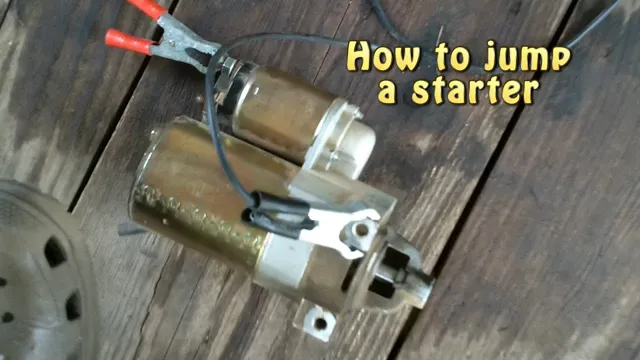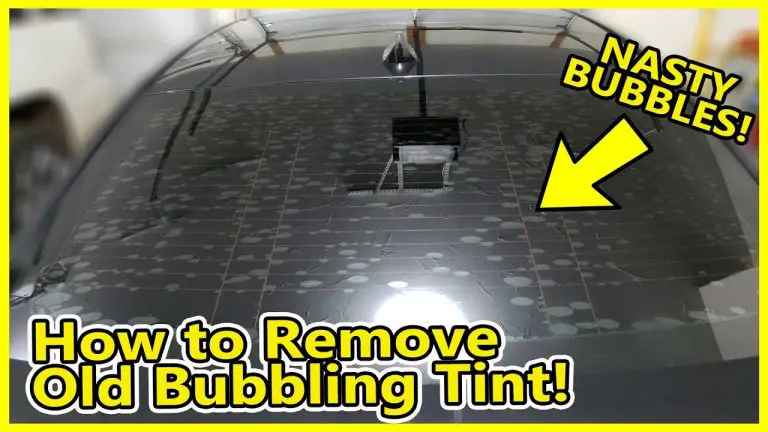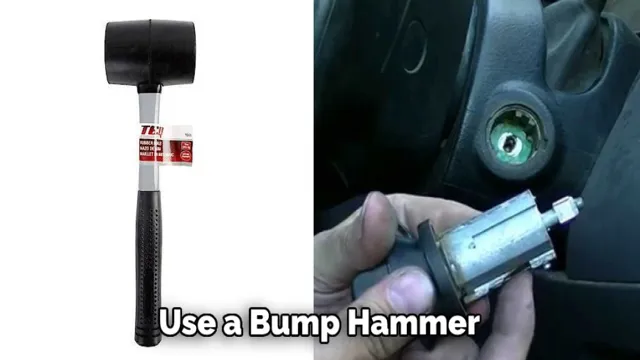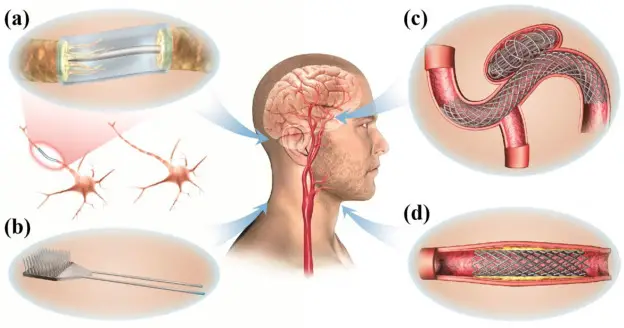Jumpstarting Your Engine: A Step-by-Step Guide to Jumping a Starter Solenoid
Have you ever experienced that sinking feeling as you turn the key in your car and…
nothing? Your car won’t start, leaving you stranded, frustrated, and possibly late for work or an appointment. Before you call for a tow, it’s worth checking your starter solenoid to see if that’s the culprit. If you’re not sure what a starter solenoid is or how to jump it, don’t worry! We’ve created a step-by-step guide to help you diagnose the problem and get back on the road in no time.
Think of it like a defibrillator for your car – a quick jolt to the system to get your engine going. So grab your tools and let’s get started!
What is a Starter Solenoid?
A starter solenoid is a crucial component of your car’s ignition system. It is responsible for transmitting electrical current from the battery to the starter motor, which in turn cranks the engine. When you turn the key in the ignition, the starter solenoid receives a signal from the battery to engage the motor.
If you’re having trouble starting your car, it could be due to a faulty starter solenoid. In such cases, you can jump the starter solenoid to start your car. Just connect a jumper wire between the battery’s positive terminal and the starter solenoid’s positive terminal to bypass the solenoid and engage the starter motor directly.
However, it’s important to exercise caution while doing this, as it involves working with electrical currents and can be dangerous if done incorrectly or without proper knowledge.
Understanding the Basics
A starter solenoid is a crucial component in a vehicle’s starting system. It acts as a switch that allows the battery’s current to flow to the starter motor, which in turn cranks the engine. The solenoid is typically located on or near the starter motor and is activated by a key in the ignition, or in some cases, a push-button starter.
When the vehicle is turned on, a small electromagnet inside the solenoid pulls a plunger towards it, which in turn makes electrical contact and allows current to flow through the solenoid and start the engine. Without a functioning starter solenoid, a vehicle will not start, so it is important to ensure it is working properly.

Tools You Will Need
Jumpstarting a starter solenoid can be a useful skill to have in case of an emergency or when you need to diagnose a problem with your vehicle. To do this, you will need a few tools, including a jumper cable and a volt meter. The first step is to locate the starter solenoid, which is typically found near the battery or on the fender well.
Next, connect the negative end of the jumper cable to a good metal ground on the engine and the positive end to the solenoid’s small wire terminal. Use the volt meter to measure the voltage at the solenoid’s large battery cable terminal. If the voltage is less than 10 volts, you may need to replace the battery or charging system.
Once everything is connected, turn the ignition key to the “on” position to allow power to flow. If the engine cranks, then you have successfully jumpstarted the starter solenoid. Remember to disconnect the jumper cable afterward.
With these tools and steps, you can easily jumpstart your starter solenoid without having to rely on a tow truck or mechanic.
Gathering the Essentials
When it comes to starting any type of project, the right tools can make all the difference. Gathering the essentials for your task at hand is crucial in ensuring its success. When it comes to DIY projects, there are a few tools that should be in everyone’s tool kit.
Firstly, a reliable hammer that can be used for a variety of tasks is essential. Additionally, a screwdriver set with various sizes and heads can come in handy for assembling furniture or replacing light switch covers. A measuring tape is also crucial for ensuring that everything is level and properly aligned.
Other important tools include pliers, a level, and a set of saws. And let’s not forget about safety gear such as gloves, goggles, and a dust mask to protect yourself while working. By gathering these essential tools, you can ensure that your DIY project goes off without a hitch.
How to Jump Your Starter Solenoid
Jump starting a car is a common solution to a dead battery, but what if the issue lies with your starter solenoid? Knowing how to jump a starter solenoid can save you the hassle and expense of calling a mechanic or waiting for a tow truck. First, locate your solenoid, typically found on the starter motor or on the fender well near the battery. Next, make sure your vehicle is in park or neutral and the ignition is off.
Check for any signs of corrosion or damage on the wiring and connections. Using a metal object, such as a screwdriver or wrench, touch the metal post on the solenoid while simultaneously touching the positive battery terminal. If your car starts, the solenoid may be faulty and will need to be replaced.
Remember to exercise caution when handling electrical components and disconnect the battery before attempting any repairs. By learning how to jump a starter solenoid, you can quickly diagnose and fix the issue, getting you back on the road in no time.
Step 1: Identify Your Solenoid’s Location
Jumping your starter solenoid can be a lifesaver when your car won’t start. But before you can begin, you need to know the location of your solenoid. Typically, you’ll find it attached to the starter motor, under the hood of your car.
If you’re not sure where to look, consult your car’s owner’s manual or do a quick online search. Once you’ve located the solenoid, it’s time to move on to the next step in the process. Remember, identifying the location of your solenoid is critical for ensuring you can safely and effectively jump-start your car.
With this information in hand, you’ll be better prepared to tackle any car trouble that comes your way.
Step 2: Connect the Jumper Cables
Jumping your starter solenoid can save you from being stranded on the road or in your driveway. Before you begin, make sure your car is in park or neutral and the parking brake is engaged. Locate the positive and negative battery terminals.
Next, connect the red cable to the positive terminal of the dead battery and the other end to the positive terminal of the live battery. Then, connect the black cable to the negative terminal of the live battery and the other end to an unpainted metal surface on the car with the dead battery. Finally, attempt to start the car with the dead battery.
If it starts, allow it to run for a few minutes before disconnecting the cables. Remember, always double-check connections and make sure to follow safety precautions. Jump-starting your car can be a temporary solution, so make sure to have your car inspected by a professional as soon as possible.
The main keyword organically used here is “Jump Starter solenoid.”
Step 3: Turn on the Ignition Switch
Jump Your Starter Solenoid Once you have connected the jumper cables correctly, it is time to turn on the ignition switch. It is important to do this step carefully, as it can be dangerous if not done properly. Before turning on the ignition switch, make sure that all cables are away from the engine and not touching any moving parts.
Once you have confirmed this, you can turn the key to the ‘on’ position. You should be able to hear the solenoid click, and the engine should start. If it doesn’t, you may need to try the process again, or it may be a sign of a more serious issue with your vehicle’s electrical system.
Remember to always practice caution when jumping a starter solenoid, and to seek professional help if necessary. With these steps in mind, you should be able to jump your starter solenoid safely and effectively.
Step 4: Listen for Engine Noise
When jumpstarting your car, it’s essential to pay attention to engine noise. If you hear any strange sounds coming from your engine, it could be an indication of a problem. Ideally, the engine should start smoothly and quietly, without any banging or grinding sounds.
If you hear any of these noises, it’s best to turn off the engine immediately and look for an expert mechanic to assess the situation. Sometimes, the engine might start but continue to make unusual sounds. This could be a sign of poor battery health or a defective starter.
In such a case, consider replacing the battery or starter to avoid any further complications. Remember always to put safety first when jumpstarting your car and follow the correct procedure to minimize any risks. With a little bit of patience and care, you should have your car running smoothly in no time.
Step 5: Disconnect the Jumper Cables
Once you’ve successfully jumped your starter solenoid, it’s time to disconnect the jumper cables. Start by turning off the vehicle that was used to jump your car. Then, remove the negative cable from the battery of that vehicle.
Next, remove the negative cable from your own car battery, followed by the positive cable from the other vehicle’s battery and, finally, the positive cable from your own battery. It’s important to keep in mind that the order of removal is crucial to prevent any sparks or electrical shocks. Once all cables have been removed, you’re ready to turn on your car and hit the road.
Remember to keep an eye on your car battery for any signs of damage or wear, and consider having it checked by a professional if the problem persists. With a little bit of know-how, jumping your starter solenoid can be a simple and effective solution to get you back on the road.
Potential Risks and Precautions
Jump starting a starter solenoid can be a risky task, especially if you’re not familiar with the proper precautions. Before attempting this task, it’s important to disconnect the battery and ensure that all electrical components are turned off. You should also wear protective gloves and eyewear to prevent injury.
It’s also important to only jump the solenoid for a short period of time, as leaving it connected for too long can cause damage to the starter or other electrical components. In addition, it’s important to be mindful of the potential burst of energy that can occur during the jump starting process. By taking these precautions and being mindful of the risks involved, you can safely jump start your starter solenoid without causing any harm to yourself or your vehicle.
Staying Safe While Jumping Your Solenoid
Jumping your solenoid can be a tricky process, but it is necessary at times to get your car up and running. However, it’s important to understand the potential risks involved and take precautions to stay safe. One of the biggest risks is electrical shock, which can be fatal if not handled properly.
To prevent this, make sure to wear protective gear like gloves and eye protection, and keep the area dry. Another risk is damage to your car’s electrical system, which can cause expensive repairs. To avoid this, double-check that you are using the correct tools and following the manufacturer’s instructions.
It’s always better to be safe than sorry, so if you’re unsure, it’s best to call a professional. By taking these precautions, you can ensure that your car starts smoothly and safely.
Conclusion and Final Thoughts
Jumping a starter solenoid is like giving your car a little electric kick in the pants. It’s a quick and easy way to get your engine going when it’s feeling a little sluggish. And just like a good cup of coffee, sometimes all it takes is a jolt of electricity to get things moving in the right direction.
So if you’re feeling a little stuck, don’t be afraid to jump that solenoid and get back on the road to success!”
FAQs
What is a starter solenoid and what does it do?
A starter solenoid is a device that connects the starter motor to the battery and initiates the engine’s cranking cycle when the key is turned. It essentially acts as an electrical switch in the starting process.
How do I know if my starter solenoid is faulty?
If your engine doesn’t crank or start when you turn the key, it could be due to a faulty starter solenoid. You can also check for a clicking sound when you turn the key, as this is a common symptom of a bad solenoid.
Can I jumpstart my starter solenoid to get my car started?
Yes, you can jump a starter solenoid to get your car started if you suspect the problem is caused by a dead battery. Use jumper cables to connect the positive terminal of the battery to the positive terminal of the solenoid and the negative terminal of the battery to the engine block or other grounded metal surface.
How do I replace a starter solenoid?
To replace a starter solenoid, you will need to disconnect the battery, locate the solenoid on the starter motor, remove any mounting bolts or wires that are connected to it, and replace it with a new solenoid. Be sure to follow the manufacturer’s instructions and safety guidelines to avoid injury or damage to your vehicle.






